Meteorologists and scientists have a new tool at their disposal; NASA’s new CloudSat satellite, which is capable of building 3-D images of clouds. CloudSat launched on April 28 from Vandenberg Air Force Base with two other satellites. After several weeks of testing, mission managers tested its Cloud-Profiling Radar system in May. Its first image was a slice of atmosphere above the North Sea in the Atlantic Ocean. CloudSat’s radar system is 1,000 times more powerful than typical weather radar.
Continue reading “First Images From Cloudsat”
Tau Scorpii’s Magnetic Fields Blaze X-Rays
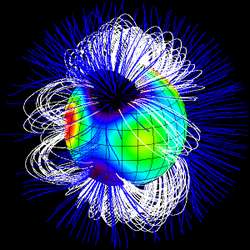
Magnetic field lines at the surface of Tau Scorpii. Image credit: M. M. Jardine/J. F. Donati. Click to enlarge
Our Sun can send out its share of solar flares and coronal mass ejections, but compared to other stars, it’s relatively calm. One example is tau Scorpii, 5-6 times larger than the Sun and visible with the unaided eye. Astronomers have discovered that it has a complex network of magnetic field lines which channel its solar winds into thin arcs. The high points of these arcs blaze brightly in the x-ray spectrum.
An international team of astronomers has discovered that the naked-eye star, tau Scorpii, unexpectedly hosts a complex network of magnetic field lines over its surface.
Our Sun has its explosive flares and spots and high speed wind, but it is a placid star compared to some. Stars that are much more massive live fast and die young, with blue-white, intensely hot surfaces that emit energy at a rate millions of times greater than that of the Sun. These stars are so bright that their light alone propels outflowing stellar winds – up to a billion times stronger than the solar wind – at speeds of up to 30,000 km/s, or one per cent of the speed of light.
Tau Scorpii has been known for some time to emit X-rays at an unusually high rate and to rotate more slowly than most otherwise similar stars. The newly discovered magnetic field, presumably a relic from the star’s formation stage, goes some way to explaining both characteristics, although the mechanism by which the magnetic field slowed down tau Scorpii’s rotation so strongly remains mysterious.
These results will be published in the Monthly Notices of the Royal Astronomical Society.
The processes by which hot, massive stars expel their surface layers through their strong outflowing winds have a major impact on a star’s long-term fate. The cast-off material can also interact with other nearby stars, contribute matter and energy to the surrounding interstellar medium, and even induce bursts of new star formation. Hot massive stars are thus key actors in the life of a galaxy.
One such hot star is tau Scorpii, whose intrinsic brightness is so great that it is easily visible with the naked eye, despite its distance of over 400 light-years. Weighing as much as 15 Suns, tau Scorpii is 5 to 6 times bigger and hotter than our own star. Such massive stars are relatively few in number compared to stars like the Sun, and tau Scorpii is actually one of our closest massive neighbours.
Massive stars are thought to emit X-rays because of supersonic shocks occurring within their outflowing winds. However, tau Scorpii is an unusually strong X-ray source compared to stars which are otherwise similar.
The reason for this enhanced activity was a puzzle until the present discovery, which revealed that the star hosts a complex network of magnetic field lines over its surface (see image). According to the discovery team, this field is most probably a relic from the star’s formation stage.
The most interesting aspect, though, is how the field interacts with the wind, forcing it to flow along magnetic field lines, like beads along wires. Wind streams along ‘open’ magnetic field lines (shown in blue) freely escape the star, something that wind streams in magnetic ‘arcades’ (shown in white) cannot achieve. The result is that, within each magnetic arcade, wind flows from both footprints collide with each other at the loop summits, producing tremendously energetic shocks and turning the wind material into blobs of million-degree, X-ray emitting plasma tied to the magnetic loops.
This model provides a natural explanation of why tau Scorpii is such an intense X-ray emitter. However, it is not yet clear how the magnetic field succeeded in slowing down the rotation rate of the star to less than one-tenth that of otherwise similar, non-magnetic, massive stars.
Sun-like stars can be slowed down through their magnetic wind, just as ice-skaters are spun down when outstretching their arms. Tau Scorpii does not, however, lose material fast enough to have its rotation modified within its very short lifetime of a few million years.
The researchers discovered and examined the magnetic field of the star by looking at the tiny, very specific polarisation signals that magnetic fields induce in the light of magnetic stars. To do this, they used ESPaDOnS, by far the most powerful instrument in the world for carrying out this kind of research. This new instrument, currently attached to the Canada-France-Hawaii Telescope on Hawaii, was specially designed at the Observatoire Midi-Pyrenees in France for observing and studying magnetic fields in stars other than the Sun.
Original Source: AAS News Release
Amazing Astrophotos in the Forum
I just wanted to draw your attention to the Astrophotography section of the Bad Astronomy/Universe Today forum. Members have been posting tons of amazing images every day; too many for me to feature in Universe Today. Here’s the catch, though. You have to be a member of the forum to see the photos. Membership is totally free, just register from this page.
And speaking of the forum, one of our members, parallaxicality, recently wrote up an article on Wikipedia that was recently featured as one of the best articles on the site. Read about the Definition of a Planet, and then give your congrats to parallaxicality.
Fraser Cain
Publisher
Universe Today
P.S. The American Astronomical Society is having its annual meeting in Calgary this year, and they’re generating enormous amounts of news. Universe Today is going to be pretty big for the next few days. Enjoy.
Supernova Remnant Isn’t Dusty Enough
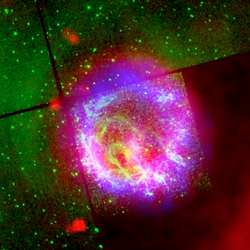
Dusty supernova remnant. Image credit: NASA/JPL-Caltech. Click to enlarge
A supernova remnant in the Small Magellanic Cloud is only 1,000 years old; making it one of the youngest ever discovered. However, astronomers are puzzled about its strange lack of dust. Current theories about supernovae predict that it should have 100 times the dust that astronomers can detect. It’s possible that the supernova shockwaves prevented dust formation, or large amounts of colder dust just haven’t been seen by infrared instruments.
One of the youngest supernova remnants known, a glowing red ball of dust created by the explosion 1,000 years ago of a supermassive star in a nearby galaxy, the Small Magellanic Cloud, exhibits the same problem as exploding stars in our own galaxy: too little dust.
Recent measurements by University of California, Berkeley, astronomers using infrared cameras aboard NASA’s Spitzer Space Telescope show, at most, one-hundredth the amount of dust predicted by current theories of core-collapse supernovae, barely the mass of the planets in the solar system.
The discrepancy presents a challenge to scientists trying to understand the origins of stars in the early universe, because dust produced primarily from exploding stars is believed to seed the formation of new-generation stars. While remnants of supermassive exploding stars in the Milky Way galaxy also show less dust than predicted, astronomers had hoped that supernovae in the less-evolved Small Magellanic Cloud would accord more with their models.
“Most of the previous work was focused only on our galaxy because we didn’t have enough resolution to look further away into other galaxies,” said astrophysicist Snezana Stanimirovic, a research associate at UC Berkeley. “But with Spitzer, we can obtain really high resolution observations of the Small Magellanic Cloud, which is 200,000 light years away. Because supernovae in the Small Magellanic Cloud experience conditions similar to those we expect for early galaxies, this is a unique test of dust formation in the early universe.”
Stanimirovic reports her findings in a presentation and press briefing today (Tuesday, June 6) at a meeting of the American Astronomical Society in Calgary, Alberta, Canada.
Stanimirovic speculates that the discrepancy between theory and observations could result from something affecting the efficiency with which heavy elements condense into dust, from a much higher rate of dust destruction in energetic supernova shock waves, or because astronomers are missing a very large amount of much colder dust that could be hidden from infrared cameras.
This finding also suggests that alternative sites of dust formation, in particular the powerful winds from massive stars, may be more important contributors to the dust pool in primordial galaxies than are supernovae.
Massive stars – that is, stars that are 10 to 40 times bigger than our sun – are thought to end their lives with a massive collapse of their cores that blows the outer layers of the stars away, spewing out heavy elements like silicon, carbon and iron in expanding spherical clouds. This dust is thought to be the source of material for the formation of a new generation of stars with more heavy elements, so-called “metals,” in addition to the much more abundant hydrogen and helium gas.
Stanimirovic and colleagues at UC Berkeley, Harvard University, the California Institute of Technology (Caltech), Boston University, and several international institutes form a collaboration called the Spitzer Survey of the Small Magellanic Cloud (S3MC). The group takes advantage of the Spitzer telescope’s unprecedented resolution to study interactions in the galaxy between massive stars, molecular dust clouds and their environment.
According to Alberto Bolatto, a research associate at UC Berkeley and principal investigator of the S3MC project, “the Small Magellanic Cloud is like a laboratory for testing dust formation in galaxies with conditions much closer to those of galaxies in the early universe.”
“Most of the radiation produced by supernova remnants is emitted in the infrared part of the spectrum,” said Bryan Gaensler of the Harvard-Smithsonian Center for Astrophysics in Cambridge, Mass. “With Spitzer, we can finally see what these objects really look like.”
Called a dwarf irregular galaxy, the Small Magellanic Cloud and its companion, the Large Magellanic Cloud, orbit the much larger Milky Way. All three are around 13 billion years old. Over eons, the Milky Way has pushed and pulled these satellite galaxies, creating internal turbulence probably responsible for the slower rate of star formation, and thus the slowed evolution that makes the Small Magellanic Cloud look like much younger galaxies seen farther away.
“This galaxy has really had a wild past,” Stanimirovic said. Because of this, however, “the dust content and the abundance of heavy elements in the Small Magellanic Cloud are much lower than in our galaxy,” she said, “while the interstellar radiation field from stars is more intense than in the Milky Way galaxy. All these elements were present in the early universe.”
Thanks to 50 hours of observing with Spitzer’s Infrared Array Camera (IRAC) and Multiband Imaging Photometer (MIPS), the S3MC survey team imaged the central portion of the galaxy in 2005. In one piece of that image, Stanimirovic noticed a red spherical bubble that she discovered corresponded exactly with a powerful X-ray source observed previously by NASA’s Chandra X-ray Observatory satellite. The ball turned out to be a supernova remnant, 1E0102.2-7219, much studied during the past few years in the optical, X-ray and radio bands, but never before seen in the infrared.
Infrared radiation is emitted by warm objects, and in fact, radiation from the supernova remnant, visible in only one wavelength band, indicated that the 1,000-year-old dust bubble was nearly uniformly 120 Kelvin, corresponding to 244 degrees Fahrenheit below zero. E0102, among the youngest third of all known supernova remnants, probably resulted from the explosion of a star 20 times the size of the sun, and the debris has been expanding at about 1,000 kilometers per sec (2 million miles per hour) ever since.
The infrared data provided an opportunity to see if earlier generations of stars – ones with low abundances of heavy metals – correspond more closely to current theories of dust formation in exploding supermassive stars. Unfortunately, the amount of dust – nearly one-thousandth the mass of the Sun – was at least 100 times less than predicted, similar to the situation with the well-known supernova remnant Cassiopeia A in the Milky Way.
The S3MC team plans future spectroscopic observations with the Spitzer telescope that will provide information about the chemical composition of dust grains formed in supernova explosions.
The work was sponsored by the National Aeronautics and Space Administration and the National Science Foundation.
NASA’s Jet Propulsion Laboratory in Pasadena, Calif., manages the Spitzer Space Telescope mission for NASA’s Science Mission Directorate, based in Washington, D.C. Science operations are conducted at the Spitzer Science Center at Caltech, also in Pasadena. JPL is a division of Caltech.
Original Source: UC Berkeley News Release
Mini Satellites Inside the Space Station
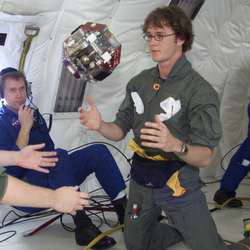
Flight test of a prototype droid by MIT undergrads. Image credit: MIT. Click to enlarge
MIT engineers recently delivered a tiny satellite to the International Space Station. About the size of a soccer ball, this tiny robot is designed to demonstrate how future satellites could be built much much smaller. It’s equipped with a set of carbon dioxide thrusters which allow it to maneuver inside the station. Two additional SPHERES (Synchronized Position Hold Engage Re-orient Experimental Satellites) will be delivered to the station over the next few years to test how they can fly in formation.
Six years ago, MIT engineering Professor David Miller showed the movie Star Wars to his students on their first day of class. There’s a scene Miller is particularly fond of, the one where Luke Skywalker spars with a floating battle droid. Miller stood up and pointed: “I want you to build me some of those.”
So they did. With support from the Department of Defense and NASA, Miller’s undergraduates built five working droids. And now, one of them is onboard the International Space Station (ISS).
“It only looks like a battle droid,” laughs Miller. It’s actually a tiny satellite-the first of three NASA plans to send to the ISS. Together, they’ll navigate the corridors of the space station, learning how to fly in formation.
Tiny satellites are a hot new idea in space exploration: Instead of launching one big, heavy satellite to do a job, why not launch lots of little ones? They can orbit Earth in tandem, each doing their own small part of the overall mission. If a solar flare zaps one satellite – no problem. The rest can close ranks and carry on. Launch costs are reduced, too, because tiny satellites can hitch a ride inside larger payloads, getting to space almost free of charge.
But there’s a problem: Flying in formation is trickier than it sounds. Ask a crowd of people to line up single file, and they’ll be able to figure it out and do it rather easily. Getting a group of orbiting satellites to do the same thing, it turns out, is extremely hard.
“Suppose you’ve got a cluster of satellites in orbit,” says Miller, “and one or two of them lose their place.” Maybe a solar flare temporarily scrambles their nav-computers, or a thruster firing didn’t work as expected. The whole cluster finds itself out of whack. Correcting the problem requires a complex set of 3-dimensional adjustments, coordinated among all the satellites-perhaps dozens or hundreds of them. “We’ve got to break this down into step-by-step, concrete instructions that a computer can understand,” Miller says.
And that takes us back to the ISS:
Miller’s challenge to his undergraduate engineering class back in 1999 was to design a small, roughly spherical robot that could float aboard the ISS and maneuver using compressed CO2 thrusters. The project, called SPHERES (Synchronized Position Hold Engage Re-orient Experimental Satellite), would serve as a testbed for trying out experimental software to control clusters of satellites. The robotic spheres provide a generic platform consisting of sensors, thrusters, communications and a microprocessor; scientists working on new software ideas can load their software into that platform to see how well those ideas work. It’s a quick and relatively cheap way to test new theories on software design.
Possible applications include NASA’s return to the Moon (see the Vision for Space Exploration). One way to build a moonship is to assemble it piece by piece in Earth orbit. “Software designed to control small satellites could just as well be used to maneuver the pieces of a spaceship together,” says Miller.
The first SPHERE arrived on the ISS in April tucked inside a Progress supply rocket. (Remember, tiny satellites make good hitchhikers.) Eventually two more SPHERES will join it, one later this year when the space shuttle Discovery (STS-121) returns to the station, and another carried to orbit by a future shuttle mission.
How will astronauts tell the three SPHERES apart? “They’re color coded,” explains Miller. The one onboard now is red; the second will be blue and the third yellow.
“Red” is already busy. “We’ve commanded it to do a variety of maneuvers-loops and turns, for instance. And we’ve tested the robot’s ability to solve problems.” Astronauts tried to trick Red by causing one of its thrusters to stick “on.” The robot diagnosed the fault, turned the thruster off, and returned to station-keeping.
“Not bad for one little droid,” says Miller. “I can’t wait to see what three of them can do.”
Original Source: NASA News Release
Extreme Galaxies Help Explain the Early Universe
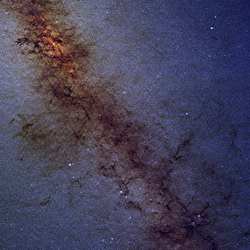
The center of our Milky Way galaxy. Image credit: NASA. Click to enlarge
Astronomers are studying nearby “luminous infrared galaxies” to get a better idea of what extremely distant galaxies might look like. Some of these galaxies are 1/50th the size of the Milky Way (2000 light-years across), but they have the same amount of gas. This tightly packed gas causes nearly constant star formation, and feeds supermassive black holes. This is probably what the early Universe looked like.
If you can’t travel to the picturesque sands of Waikiki Beach, you can always do the next-best thing and visit a local shore. Both “hot spots” will get plenty of sun.
Astronomers are using a similar sightseeing tactic, studying nearby extreme galaxies known as “luminous infrared galaxies” to learn about their distant counterparts in the early universe. Astronomer Christine Wilson (Smithsonian Astrophysical Observatory/McMaster University) and her colleagues have found some surprising commonalities between these extreme galaxies and their mundane cousins like the Milky Way.
“These galaxies are unusual in some ways, but surprisingly normal in others,” said Wilson. “They’re like giant sequoias – they look spectacular, but they grow from the same dirt as your basic shrub.”
Wilson presented her team’s findings today in a press conference at the 208th meeting of the American Astronomical Society.
Luminous and ultraluminous infrared galaxies are islands of stars and dust that emit the great majority (90-99 percent) of their light at long infrared wavelengths. All known examples show evidence for galaxy interactions and mergers that are stirring them up. Gas and dust crash together at the centers of these galaxies, fueling tremendous bursts of star formation or feeding giant central black holes.
“All the action in these galaxies is happening at their centers,” said Wilson.
Similar interactions were much more common in the early universe when galaxies were closer together. Observations have detected many examples of extreme galaxies at distances of 8 to 10 billion light-years. At those great distances, detailed study is difficult with current instruments, hence astronomers’ interest in their nearby counterparts.
To investigate these galactic “hot spots,” Wilson and her colleagues employed the Smithsonian’s Submillimeter Array. The high spatial resolution of the Array was crucial for this study, allowing the team to probe galactic centers where most of the star formation is taking place.
“Some of these galaxies have as much gas as the Milky Way crammed into a region only 2,000 light-years across – one-fiftieth (1/50) the size of our Galaxy,” explained Wilson.
About three-fourths of the time, that gas powers bursts of star formation. In other cases, the gas feeds a giant black hole. Either way, a lot of energy gets pumped out in the infrared.
Wilson and her colleagues determined the total amounts of gas and dust within each of the five most luminous galaxies they studied. They divided the two numbers to calculate the gas-to-dust ratio.
Galaxies like the Milky Way typically contain about 100 times more gas than dust. Surprisingly, the extreme infrared galaxies showed similar values.
“Given their unusual environment, I’m not sure I would have expected to see a normal gas to dust ratio,” said Wilson. “The fact that we DO see a normal value suggests not only that our mass calculations are correct, but also that these galaxies are more like our own than we might have guessed.”
Luminous infrared galaxies also show some interesting differences from their cousins in the early universe. For example, distant galaxies typically are 10 times brighter in molecular emissions, which indicates that they contain more gas. That gas also tends to move faster, providing evidence that the galaxies are more massive. Most interestingly, distant extreme galaxies appear to be larger in size, which suggests that the gas density may actually be lower in these distant galaxies despite their larger total amount of gas.
Future work by Wilson and her team will focus on determining how galaxy properties change as interactions and mergers progress over time.
Headquartered in Cambridge, Mass., the Harvard-Smithsonian Center for Astrophysics (CfA) is a joint collaboration between the Smithsonian Astrophysical Observatory and the Harvard College Observatory. CfA scientists, organized into six research divisions, study the origin, evolution and ultimate fate of the universe.
Original Source: CfA News Release
Most Distant Galaxy Cluster Discovered
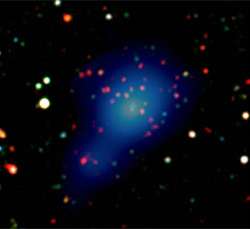
An international team of astronomers have used ESA’s XMM-Newton X-Ray observatory to image the most distant galaxy cluster ever seen. This cluster contains hundreds of galaxies, and is located nearly 10 billion light-years from Earth, so it’s seen when the Universe was less than 4 billion years old. Its existence challenges current theories about galaxy evolution – a structure this large shouldn’t exist so early in the Universe.
The most distant cluster of galaxies yet has been discovered by astronomers from the U.S., Europe and Chile. The finding was announced at the 208th American Astronomical Society meeting in Calgary, June 5.
Almost 10 billion light-years from Earth, cluster XMM-XCS 2215-1734 contains hundreds of galaxies surrounded by hot X-ray-emitting gas.
The existence of the cluster so early in the history of the universe challenges ideas about how galaxies formed, said lead author Adam Stanford, a research scientist at UC Davis and the Lawrence Livermore National Laboratory.
“It’s like finding a picture of your grandfather as an adult in the nineteenth century — how could he have existed so long ago?” Stanford said.
Using the temperature of the X-ray emitting gas, Kivanc Sabirli, a graduate student at Carnegie Mellon University, determined that the cluster is approximately 500 trillion times the mass of our sun. Most of the mass is “dark matter,” a mysterious, invisible form of matter that dominates the mass of all galaxies in the universe.
The XMM Cluster Survey (XCS) team used observations from the European X-ray Multi Mirror (XMM) Newton satellite to discover the cluster and then determined its distance from Earth using the 10-meter W.M. Keck telescope in Hawaii. The team is working on a long-term observing program to find hundreds more such clusters using telescopes around the world.
In addition to Stanford and Sabirli, the research team includes: Kathy Romer, University of Sussex, U.K.; Michael Davidson and Robert G. Mann, University of Edinburgh and the Royal Observatory Edinburgh, U.K.; Matt Hilton and Christopher A. Collins, Liverpool John Moores University, U.K.; Pedro T.P. Viana, Universidade do Porto, Portugal; Scott T. Kay, Oxford University, U.K.; Andrew R. Liddle, University of Sussex, U.K.; Christopher J. Miller, National Optical Astronomy Observatory, Tucson; Robert C. Nichol, University of Portsmouth, U.K.; Michael J. West, University of Hawaii and the Gemini Observatory, Chile; Christopher J. Conselice, University of Nottingham, U.K.; Hyron Spinrad, UC Berkeley; Daniel Stern, Jet Propulsion Laboratory; and Kevin Bundy, California Institute of Technology. The work was funded by NASA, the Particle Physics and Astronomy Research Council (U.K.), the Hosie Bequest, and the National Science Foundation.
Original Source: UC Davis News Release
Hundreds of Distant Galaxy Clusters Discovered
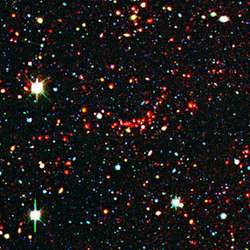
Distant clusters of galaxies. Image credit: NASA/JPL-Caltech. Click to enlarge
NASA’s Spitzer Space Telescope has turned up 300 galaxy clusters at extreme distances; 8 – 10 billion light-years away. Galaxy clusters have been seen at extreme distances before, but never so many. This gives astronomers the ability to study their formation and evolution with many different examples. The discovery was made by combining images from Spitzer and optical light telescopes, to identify which galaxies are relatively nearby, and which are more distant.
A team of astronomers using NASA’s Spitzer Space Telescope has discovered a grand total of nearly 300 clusters of galaxies. Almost 100 of these are as far as 8 to 10 billion light-years away, which means they date back to a time when our universe was less than one-third its present age.
Galaxy clusters are the universe’s high-density environments, similar to cities on Earth. A single galaxy cluster can contain hundreds of galaxies like our own Milky Way.
“At this distance, we are literally looking at these galaxies as they were over 8 billion years ago,” said Dr. Mark Brodwin of NASA’s Jet Propulsion Laboratory in Pasadena, Calif., who co-led the discovery. “It’s like being able to take a picture of Rome during the peak of the Roman Empire.”
Brodwin presented the results today at the 208th meeting of the American Astronomical Society in Calgary, Canada.
Such observations should lead researchers to a better understanding of how massive galaxies form and evolve. “The oldest and most massive galaxies in the universe live in clusters,” said co-discoverer Dr. Anthony Gonzalez of the University of Florida, Gainesville. “This sample is exciting because, for the first time, we are able to look at these massive cluster galaxies while they are still forming and better understand when they formed their stars.”
While galaxy clusters have previously been found at similar distances, this is the first time that so many clusters have been detected so far away. In December of 2005 and March of 2006, the team reported finding two galaxy clusters located 9.1 and 8.2 billion light-years away, respectively. Today, they announced the discovery of 290 clusters of varying distances, some of which are referred to as galaxy “groups” because they contain fewer members. The nearly 100 distant clusters and groups belonging to this sample represent a six-fold increase over what was previously known.
According to the astronomers, the key to their success was a combination of infrared and optical imaging from Spitzer and Kitt Peak National Observatory in Arizona. The distant galaxies making up the clusters light up in the infrared images, but they cannot be distinguished from other galaxies lying between us and them. By combining the Spitzer images with those from Kitt Peak showing mainly the intervening galaxies, the scientists were able to isolate the distant ones. Finding the clusters of distant galaxies then becomes simply a matter of looking for dense clumps of distant objects.
“Distant galaxies show up best in infrared because during the billions of years it takes to reach us, their light expands along with the universe to longer, infrared wavelengths,” said team member Dr. Peter Eisenhardt of JPL, who led the Spitzer observations.
“With Spitzer, we were able to make deep infrared maps thousands of times faster than with the biggest ground-based telescopes, covering enough sky to find these relatively rare clusters. By adding the deep Kitt Peak optical maps, we could weed out all the galaxies cluttering up the view between us and these distant clusters.”
So far, the distances to seven of the farthest clusters identified have been confirmed using detailed data from the W.M. Keck Observatory in Mauna Kea, Hawaii.
The team will continue to study these ancient galactic cities using Spitzer and NASA’s Hubble Space Telescope. They hope to begin tackling two major questions: just how big are these cities, and how do they grow?
Brodwin is a native of Canada from Montreal. Other team members include: Dr. Adam Stanford of the University of California at Davis; Dr. Daniel Stern of JPL; Drs. Buell Jannuzi and Arjun Dey of the National Optical Astronomy Observatory, Tucson, Ariz.; and Dr. Michael J. I. Brown of Princeton University, Princeton, New Jersey.
JPL manages the Spitzer Space Telescope mission for NASA’s Science Mission Directorate, Washington. Science operations are conducted at the Spitzer Science Center at the California Institute of Technology in Pasadena. Spitzer’s infrared array camera, which observed the galaxy clusters, was built by NASA’s Goddard Space Flight Center, Greenbelt, Md. The instrument’s principal investigator is Dr. Giovanni Fazio of the Harvard-Smithsonian Center for Astrophysics.
Kitt Peak National Observatory, part of the National Optical Astronomy Observatory, is funded by the National Science Foundation and located on the land of the Tohono O’odham Nation.
Original Source: Spitzer Space Telescope
Gravitational Lenses Look at Infant Galaxies
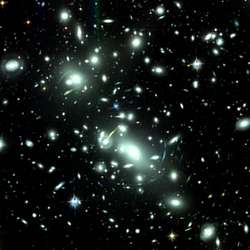
The massive cluster Abell 2218. Image credit: JHU/STScI. Click to enlarge
When regular telescopes aren’t powerful enough, astronomers turn to gravitational lenses; natural telescopes that can peer back to earliest times in the Universe. An international team of astronomers recently demonstrated this technique with Hubble. They can see how infant galaxies looked only a billion years after the Big Bang.
Using massive clusters of galaxies as “cosmic telescopes,” a research team led by a Johns Hopkins University astronomer has found what may be infant galaxies born in the first billion years after the beginning of the universe.
If these findings are confirmed, the extra magnification provided by these gargantuan natural telescopes will have given astronomers their best-ever view of galaxies as they formed in the early universe, more than 12 billion years ago, said Holland Ford, a professor in the Henry A. Rowland Department of Physics and Astronomy at the university’s Krieger School of Arts and Sciences. Ford is the head of the Hubble Space Telescope’s Advanced Camera for Surveys Science Team, which also includes researchers from the Space Telescope Science Institute, PUC in Chile, and other universities around the world.
Ford announced the team’s results this morning at the American Astronomical Society meeting in Calgary, Alberta, Canada. The team’s spectroscopic observations were made possible, he said, by gravitational lensing, the bending of light caused by gravity’s warping of space in the presence of such massive objects as clusters of galaxies.
“One of Einstein’s most startling predictions was that a gravitation field can be thought of as a distortion of space and time,” Ford said. “Gravitational lensing by massive clusters of galaxies that have about 1 million billion times more mass than the sun provide one of the most striking confirmations of Einstein’s prediction.”
Our view of distant galaxies behind a cluster can be magnified by amounts that vary from barely detectable to as many as 50 or 100 times normal size, depending on the location of the galaxy and the distribution of mass within the cluster, Ford said. The clusters are, in effect, giant cosmic telescopes that allow astronomers to find and study distant galaxies that otherwise would be too faint to study.
“Astronomers want to know when the first galaxies formed, how large and how bright galaxies are at birth, and how galaxies grow into large mature galaxies like our home Milky Way galaxy,” Ford said. “Our team is searching for infant galaxies that are less than a billion years old by comparing images of strongly lensing clusters taken by the Hubble Space Telescope with images of the same clusters taken by the Magellan, the Very Large Telescopes (VLT), and Gemini telescopes. The infant galaxies are so far away their light is almost or entirely redshifted to wavelengths that cannot be detected with Hubble’s Advanced Camera for Surveys, but can be detected with infrared detectors on the world’s largest telescopes.”
Using this technique, the ACS team has searched for infant galaxies behind 14 lensing clusters. If longer spectroscopic observations of the three brightest candidate galaxies confirm that they are indeed in the early universe, these galaxies will provide astronomers their clearest view yet of the youngest galaxies ever seen.
Today’s presentation is based on the AAS Abstract 66.03 “Bright Candidates of Galaxies at Redshift 7-8 in the ACS Cluster Fields” by Wei Zheng, H. Ford, L. Infante, V. Motta, M. Postman, and the ACS Science Team. (Johns Hopkins University, PUC, Chile, Space Telescope Science Institute.)
The ACS was developed under NASA contract NAS5-32865, and this research was supported by NASA grant NAG5-7697. These results are based on observations collected at the European Southern Observatory, Chile; the Las Campanas Magellan Telescopes in Chile; and Gemini North, a telescope operated by the Gemini Observatory/Association of Universities for Research in Astronomy.
Original Source: JHU News Release
Jupiter’s Red Spots Are Nearing Each Other
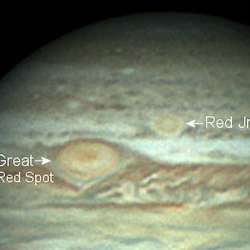
Jupiter’s two red spots. Image credit: Christopher Go. Click to enlarge
Jupiter’s well known Great Red Spot storm, and its newly formed Oval BA (aka Red Jr.) are about to sweep past each other, and astronomers aren’t quite sure what’s going to happen. The storms probably won’t merge or tear each other apart, but their outer bands will rub against each other. Oval BA recently turned red, signifying its larger size and strength compared to the smaller white storms on Jupiter. Some astronomers think the encounter with the Great Red Spot will slow it down again, returning it to white.
The two biggest storms in the solar system are about to go bump in the night, in plain view of backyard telescopes.
Storm #1 is the Great Red Spot, twice as wide as Earth itself, with winds blowing 350 mph. The behemoth has been spinning around Jupiter for hundreds of years.
Storm #2 is Oval BA, also known as “Red Jr.,” a youngster of a storm only six years old. Compared to the Great Red Spot, Red Jr. is half-sized, able to swallow Earth merely once, but it blows just as hard as its older cousin.
The two are converging. Closest approach: the 4th of July, according to Amy Simon-Miller of the Goddard Space Flight Center who has been monitoring the storms using the Hubble Space Telescope.
“There won’t be a head-on collision,” she says. “The Great Red Spot is not going to ‘eat’ Oval BA or anything like that.” But the storms’ outer bands will pass quite close to one another-and no one knows exactly what will happen.
Amateur astronomers are already monitoring the event. Christopher Go of the Philippines took the picture above using his 11-inch telescope on May 28th. “The distance between the storms is shrinking visibly every night,” he says.
Similar encounters have happened before, notes JPL’s Glenn Or ton, a colleague of Simon-Miller. “Oval BA and the Great Red Spot pass each other approximately every two years.” Previous encounters in 2002 and 2004 were anti-climatic. Aside from some “roughing” around the edges, both storms survived apparently unaltered.
This time might be different. Simon-Miller and Orton think Red Jr. could lose its red color, ironically, by passing too close to the Great Red Spot.
Red Jr./Oval BA wasn’t always red. For five years, 2000 to 2005, the storm was pure white like many other small “white ovals” circling the planet. In 2006 astronomers noticed a change: a red vortex formed inside the storm, the same color as the powerful Great Red Spot. This was a sign, researchers believed, that Oval BA was intensifying.
The color of the Great Red Spot itself is a mystery. A popular theory holds that the storm dredges up material from deep inside Jupiter’s atmosphere, lifting it above the highest clouds where solar ultraviolet rays turn “chromophores” (color-changing compounds) red. A beefed-up Oval BA could suddenly do the same.
Bumping up against the Great Red Spot, however, could weaken Oval BA, turning it white again. Simon-Miller explains: “We believe the Great Red Spot will push Oval BA toward a southern jet stream, which is blowing against the oval’s counterclockwise rotation.” This would slow Oval BA’s spin, possibly reversing the process that reddened it in the first place.
What will actually happen? “We’ll see,” she says. That’s what telescopes are for.
Note to sky watchers: Jupiter is easy to find. It pops out of the evening twilight before any other star, surprisingly bright. Look for it halfway up the southeastern sky at sunset: sky map.
Original Source: NASA News Release
